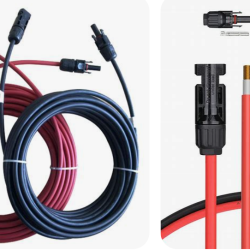Harnessing the power of the sun, solar cables play a crucial role in ensuring that the energy generated by solar panels is efficiently transmitted to where it’s needed. Picture this: a sunny day, solar panels soaking up the rays, and a network of cables working tirelessly to deliver that clean energy. But what makes these solar cables so special? How do they prevent power loss and overheating? Let’s dive into the world of solar cable construction and find out.

Solar cables, such as the En50618 solar cable, are designed with specific characteristics that make them ideal for solar energy systems. One of the key features is their ability to handle high temperatures without compromising performance. Standard cables might melt or degrade under the intense heat generated by solar panels, but solar cables are built to withstand these conditions. They’re like the unsung heroes of the solar energy world, working behind the scenes to ensure that your home or business stays powered up.
Now, let’s focus on the ‘UL solar cable’, which is a certification that ensures the cable meets specific safety standards. This is not just a random cable; it’s a cable that has been rigorously tested and certified to handle the unique demands of solar energy systems. It’s like having a cable with a badge of honor, proving its reliability and safety.
One of the standout features of solar cables, particularly the solar cable 4mm2, is their cross-sectional area. A larger cross-sectional area means more current can flow through the cable without causing it to overheat. It’s like having a wider road for the energy to travel on, reducing traffic jams and ensuring a smooth flow. This is particularly important in solar energy systems where efficiency is key.
But how do these cables prevent power loss? It’s all about resistance. Solar cables are made from materials with low resistance, which means less energy is lost as heat during transmission. It’s like having a more direct route for the energy to travel, reducing the chances of it getting lost along the way. This is a game-changer for solar energy systems, as it ensures that more of the sun’s energy is converted into usable power.
The construction of solar cables also includes features that protect against environmental factors. They’re often shielded and waterproof, which means they can withstand harsh weather conditions without degrading. This is crucial for outdoor solar installations, where cables are exposed to the elements. It’s like giving the cables an umbrella and a raincoat, ensuring they stay dry and perform at their best, no matter the weather.
Let’s not forget about the durability of solar cables. They’re built to last, with materials that resist wear and tear over time. This is especially important in solar energy systems, where cables are often exposed to UV radiation and other environmental stressors. It’s like having cables that are made of superhero material, able to withstand the test of time and keep on delivering power.
Another aspect to consider is the flexibility of solar cables. They’re designed to be flexible, which makes them easy to install and reduces the risk of damage during installation. It’s like having cables that can bend and twist without breaking, ensuring a smooth and safe installation process.
When it comes to solar cable 4mm2, the choice of material is also significant. Copper is a common choice due to its high conductivity, which means it can conduct electricity efficiently. This is important for solar energy systems, as it ensures that the energy generated by the panels is transmitted effectively. It’s like having a cable made from a superconductor, ensuring that the energy flows smoothly and without loss.
The UL solar cable certification also plays a role in ensuring the quality of the cable. This certification means that the cable has been tested for safety and performance, giving you peace of mind that the cable will perform as expected. It’s like having a cable with a seal of approval, guaranteeing its reliability and safety.
In conclusion, the construction of solar cables is a fascinating blend of science and engineering, designed to optimize the transmission of solar energy. From their ability to handle high temperatures and resist environmental factors to their low resistance and high conductivity, solar cables are the unsung heroes of the solar energy world. They ensure that the power generated by solar panels is delivered efficiently and safely, reducing power loss and overheating. So, the next time you look up at a solar panel, remember the solar cables working tirelessly behind the scenes, keeping the lights on and the power flowing.





